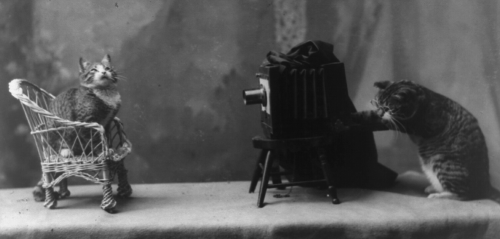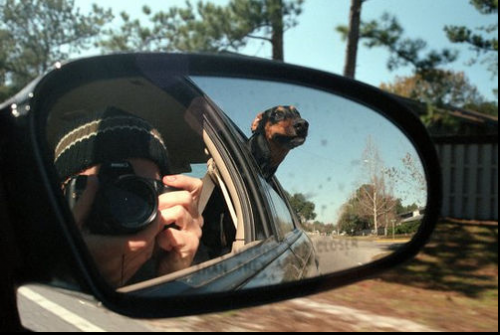 We have a lot to learn about “Nom nom nom.”
We have a lot to learn about “Nom nom nom.”
Consider the user comments for a homemade YouTube video called “Cute Kitten says ‘YUM YUM YUM’ while eating.” They include “That is one Happy cat :),” “Awwww,” and “MELTING IN HAPPINESS.” Only a few recognize the meaning of the growling noises as the cat eats from a bowl: “That kitten is saying to back off of his food!”
At more than 1.8 million views, this video belongs to a growing class of viral clips that show animals in anger, pain, or sexual arousal but are generally misinterpreted as cute, funny, and oh-so-human. Most people click, comment, and share the “cuteness” without hesitation. And that’s precisely the problem.
The web gives us new ways of seeing species other than our own. A real-time Eagle Cam can be our third eye for witnessing chicks hatch in the unmediated wild. Online videos have introduced many people to creatures—from narwhals to pangolins—that seemed only like storybook beasts until brought into roaming, gesticulating action on a screen. The armchair immediacy of nature continues to raise awareness for other species and their complex, often bafflingly familiar behavior.
Yet our desire to film or share the next funny clip can muddy our thoughts about the animal itself.
Cookie, a young male penguin at the Cincinnati Zoo and Botanical Garden, became an Internet celebrity after a video of him being “tickled” circulated on the web. One writer at Cincinatti.com, after posting about “the adorably strange giggles of Cookie,” added an update: “We spoke to the zoo, and—as someone suggested on Facebook—dear Cookie is not giggling in [the] video, but engaging in typical breeding behavior. ‘Some penguins are more vocal than others,’ said zoo spokeswoman Tiffany Barnes. Now I feel a little weird watching this.”
The mistranslation of Cookie’s cry is more awkward for the viewer than harmful to the bird. But for those animals who feel pain for the sake of a laugh, our inability to understand basic signaling behaviors of other species matters. People prod animals until they react. They may put animals in harm’s way. (People put themselves or their loved ones in danger, too—but that’s a whole other topic.) Too often, people care more about positioning the camera than interpreting their subjects.
 These misunderstandings could be happening more frequently, but more likely the Internet is making an old problem visible. The ability of such videos to be produced by anyone and spread like cholera through a public hungry for bread-faced cats potentially imperils more animals—and winnows down our ability to understand other species, let alone empathize with them.
These misunderstandings could be happening more frequently, but more likely the Internet is making an old problem visible. The ability of such videos to be produced by anyone and spread like cholera through a public hungry for bread-faced cats potentially imperils more animals—and winnows down our ability to understand other species, let alone empathize with them.
Further, online viewing sessions run the risk of becoming proxies for seeing real animals. True cat lovers would adopt a cat of their own before subsisting on icanhas.cheezburger.com. Yet those marginally interested in eagle chicks might be less likely to pursue these birds in the wild when a webcam brings the action to them. The ease of watching animals online—and, in the case of many species, their parallel retreat from regular human contact—has made secondary sources a substitute for firsthand observation.
Still, it’s only human to project our own experiences onto animals. Can we be blamed for a few misunderstandings, when Cookie’s screams do, in fact, sound like giggles?
We will never lose our human urge to anthropomorphize. Animals are our kin in this world and evolved with many of the same signaling patterns and emotional responses as humans. A purely rational appreciation of the range of animal behavior would not be appreciation at all. But even if we can’t pretend to understand all the workings of animal minds, we can learn to be closer readers of animal behavior—and this starts with face-to-face interaction. We would be better served by a walk in the woods or a stroke from the cat next door than just another suggested click.
But when you’re back, you should see the pug watching Homeward Bound. LMAO.
* * *
I enjoyed this, but have some pity on those of us who do “truly love” animals, but whose leases (or near future plans) do not permit us to adopt animals. We need our icanhazcheezburger.com fix. 🙂 If we adopted animals for which we couldn’t properly care, you’d just yell at us again (and rightly so).
There was a video that was viral recently about a white lion cub supposedly trying to “roar,” and I saw the same explanation about the video on about a dozen different sites. While I was watching the video, though, it seemed quite clear to me that the cub was crying for her mother and was in fact quite distressed. It made me sad to watch her so upset, and it was weird to think that so many people had such a wrong idea about what was happening.
I did not know that about the penguin, though.